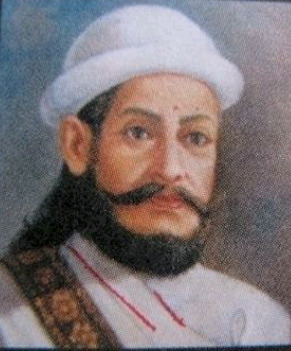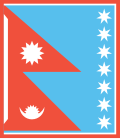Amar Singh Thapa
Amar Singh Thapa also known as Badakaji Amar Singh Thapa[note 1](Nepali: बडाकाजी अमर सिंह थापा), Budha Kazi Amar Singh Thapa or, Amar Singh Thapa The Elder was the senior commander of Nepal Army in the conquest of Western Provinces.[1] He is often hailed as Living Lion of Nepal[2] and was posthumously awarded with National heroes of Nepal,[3] who often led great battles of conquest and defence for Gurkhas in person.[4]
Amar Singh Thapa Chhetri | |
|---|---|
श्री बडाकाजी अमर सिंह थापा क्षेत्री | |
 Portrait of Bada (Elder) Amar Singh Thapa | |
| Western Commander of Nepali Army | |
| Personal details | |
| Born | 1751 A.D. (1808 B.S.) Gorkha District |
| Died | 1816 A.D. Gosain Kunda, Rasuwa District |
| Relations | Surath Singh Thapa (grandson) Ripu Mardan Thapa (grandson) Badal Singh Thapa (grandson) |
| Children | Ranadhoj Thapa Bhaktabir Thapa Narsingh Thapa Ramdas Thapa Ranajor Thapa |
| Mother | Uma Devi |
| Father | Bagh Bhim Singh Thapa |
| Awards | National heroes of Nepal (posthumous) |
| Military service | |
| Nickname(s) | Living Lion of Nepal Bada Amar Singh |
| Allegiance | |
| Rank | General |
| Battles/wars | Anglo-Nepalese war, reinforced at 2nd Nepalese-Tibetan War |
Amar Singh Thapa Media
Nishankalika flag of Bagale Thapa clan, Bada Kaji Amar Singh's ancestral clan
Gangotri Temple was built by Bada Kaji Amar Singh Thapa
References
Footnotes
- ↑ Bada Kaaji Amar Singh Thapa was distinguished from Sardar Amar Singh Thapa, PM Bhimsen's father, by terms Bada and Sanu meaning greater and lesser.
Notes
- ↑ "Nepalese Army | नेपाली सेना". Archived from the original on 2017-12-15. Retrieved 2017-12-02.
- ↑ "Cover with the seal of Amar Singh Thapa". Bilder-aus-nepal.de. Retrieved 9 November 2017.
- ↑ "National Heroes / Personalities / Luminaries of Nepal" (in en-US). ImNepal.com. 2011-12-23. http://www.imnepal.com/national-heroes-nepal/. Retrieved 2017-11-09.
- ↑ Princep 1825, pp. 459–461.
Sources
- Anon (1816), An account of the war in Nipal; Contained in a Letter from an Officer on the Staff of the Bengal Army. Asiatic journal and monthly miscellany, Vol 1. May, 1816. pp. 425–429.
- Acharya, Baburam (2012), Acharya, Shri Krishna (ed.), Janaral Bhimsen Thapa : Yinko Utthan Tatha Pattan (in Nepali), Kathmandu: Education Book House, p. 228, ISBN 978-9937-2-4174-8
{{citation}}: CS1 maint: unrecognized language (link) - Hamal, Lakshman B. (1995), Military history of Nepal, Sharda Pustak Mandir
- Fraser, James Baillie (1820), Journal of a tour through part of the snowy range of the Himālā mountains, and to the sources of the rivers Jumna and Ganges, London: Rodwell and Martin
- Pradhan, Kumar L. (2012), Thapa Politics in Nepal: With Special Reference to Bhim Sen Thapa, 1806–1839, New Delhi: Concept Publishing Company, p. 278, ISBN 978-81-8069-813-2
- Prinsep, Henry Thoby (1825), History of the political and military transactions in India during the administration of the Marquess of Hastings, 1813–1823, Vol 1, vol. 1, London: Kingsbury, Parbury & Allen
- Regmi, D.R. (1975), Modern Nepal:Expansion: climax and fall, Firma K.L. Mukhopadhyay, ISBN 978-0-88386-491-3
- Stiller, Ludwig F. (1973), The rise of the House of Gorkha: a study in the unification of Nepal, 1768–1816, Manjusri Publication House, p. 390
- Whelpton, John (1991), Kings, soldiers, and priests: Nepalese politics and the rise of Jang Bahadur Rana, 1830-1857, Manohar Publications, ISBN 978-81-85425-64-1


